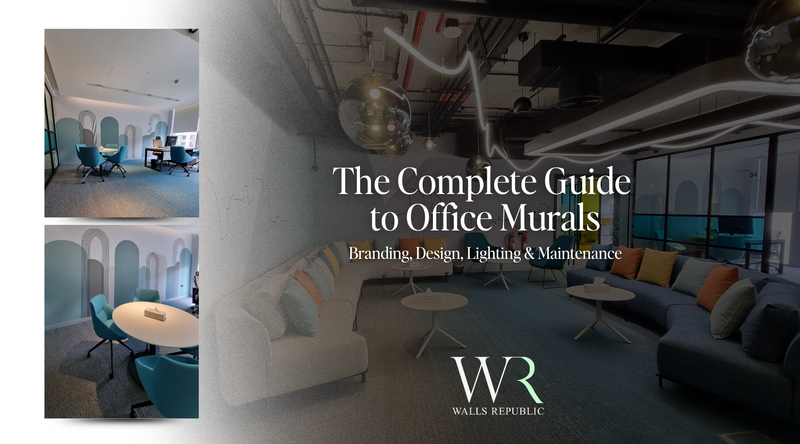
Introduction
Murals in offices and the reception are not just an ornament, but also a branding tool, a first impression and a visual point to the employees and visitors. An elegant mural sends brand messages, improves the workplace atmosphere, and acts as an inevitable backdrop to photos, happenings, and marketing materials. This guide aims at discussing the ways of planning and creating effective office murals that appear handsome, capture photographs, and survive lighting and traffic. In addition to design we will discuss resolution, choice of materials, light plans, and maintenance provisions to make sure the mural you are having can contribute quantifiable value to your workplace.
Branding Goals & Approvals

- Establish brand goals: Begin with an idea – do you want to tell a brand story on a wall, have a reception central hub, or a high-subtlety professional lobby mural? Every goal defines colors, pictorial imagery, and position.
- Work together at the start: Engage brand managers, facility teams, interior designers and marketing at initial stage. Working in teams early will cut down the chances of making expensive changes.
- Compliance & approvals: Obtain the legal and brand guardian consent on the use of trademarked pictures or licensed content. Make sure everything in graphics is in accordance with the brand.
- Brand storytelling: Add taglines, values, or mission statements as well as visuals to get the best effect. A mural can serve as branding and motivation to employees.
Large Space Resolution & DPI

- High-resolution graphics: Prefer vector graphics; otherwise, use raster images at 150–300 DPI at full print size.
- Viewing distance: DPI requirements depend on how close the mural is viewed. Reception areas require sharper details than distant walls.
- Color accuracy: Export in CMYK and calibrate with printer profiles to avoid unexpected results.
- Scaling tests: Do mock-ups before full production to confirm clarity of resolution, typography, and gradients.
Choice of Material: Impact and Cleanability

- Durability: Use Type II commercial-grade vinyl wall covering for high-traffic reception areas.
- Cleanability: Opt for stain-resistant coatings that are wipeable with mild detergents.
- Impact resistance: Flexible materials resist dents and scratches better.
- Sustainability: Choose PVC-free substrates and water-based inks for eco-friendly solutions.
Lighting: Hotspots, Glare and Balance

- Even lighting: Ensure consistent coverage from top to bottom.
- Avoid hotspots: Place lights at a distance; use wall washers or track lighting.
- Reflectivity: Matte finishes reduce glare and improve photography.
- Lighting temperature: Use warm/neutral white (3000K–4000K) for natural tones.
- Brand emphasis: Use flexible lighting to highlight logos or text subtly.
Signage and Photographic Backgrounds

- Photo-ready location: Place logos and key visuals at chest-to-eye level for photography.
- Wayfinding integration: Use subtle arrows, patterns, or colors in murals for guidance.
- Consistency: Pair murals and wayfinding signs with matching colors/fonts for cohesion.
- Instagrammable factor: Design murals that visitors will want to photograph and share.
Install & Maintenance

- Professional installation: Hire certified installers for large-format murals.
- Pre-install preparation: Walls must be smooth, clean, and primed before application.
- Maintenance plan: Schedule regular cleaning and keep spare panels for repairs.
- Fire safety compliance: Ensure murals meet ASTM E84 or equivalent fire safety standards.
- Life expectancy: Quality murals last 5–10 years with proper maintenance.

Try before you buy, Get 3 free mural samples delivered to your doorstep at just $19.
FAQs
Q1: Can I safely use my brand assets in murals?
A: Yes, but be sure to use high-resolution approved files, and make sure that they are within corporate brand guidelines. Poor quality of assets can negatively affect brand perception.
Q2: Can the murals be used as the backgrounds of the photographs?
A: Absolutely. Placed appropriately, murals supplement professional photography, and hence ideal during press releases, employee appreciation, or client conferences.
Q3: How easy are murals to clean?
A: Wipeable with mild soap and water Type II vinyl murals. Harsh abrasives should be avoided so as not to lose the life of finish and color.
Q4: What is the schedule of producing and installing mural?
A: As a measure of complexity, lead times are 2-4 weeks, as a rule. Add additional time on design approvals and approvals.
Q5: Are murals fire rating requirements?
A: Yes, office and reception murals are safe to use because of the ASTM E84 criteria which are commercial grade or local equivalents.
Q6: Is it possible to remove or update the murals?
A: Yes. Majority of commercial murals are strippable and can be easily changed without causing significant wall damage and can be updated with a lot easier during rebranding.




 1000+ reviews
1000+ reviews 